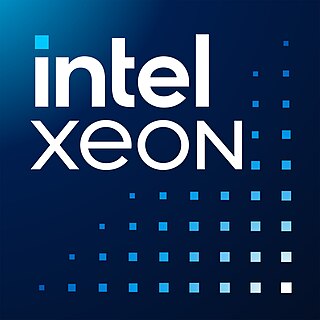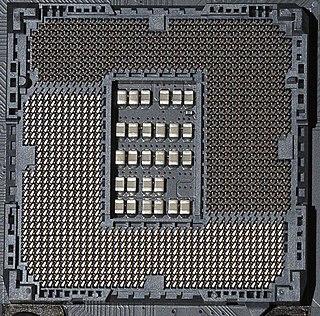Related Research Articles

Xeon is a brand of x86 microprocessors designed, manufactured, and marketed by Intel, targeted at the non-consumer workstation, server, and embedded markets. It was introduced in June 1998. Xeon processors are based on the same architecture as regular desktop-grade CPUs, but have advanced features such as support for error correction code (ECC) memory, higher core counts, more PCI Express lanes, support for larger amounts of RAM, larger cache memory and extra provision for enterprise-grade reliability, availability and serviceability (RAS) features responsible for handling hardware exceptions through the Machine Check Architecture (MCA). They are often capable of safely continuing execution where a normal processor cannot due to these extra RAS features, depending on the type and severity of the machine-check exception (MCE). Some also support multi-socket systems with two, four, or eight sockets through use of the Ultra Path Interconnect (UPI) bus, which replaced the older QuickPath Interconnect (QPI) bus.

The land grid array (LGA) is a type of surface-mount packaging for integrated circuits (ICs) that is notable for having the pins on the socket — as opposed to pins on the integrated circuit, known as a pin grid array (PGA). An LGA can be electrically connected to a printed circuit board (PCB) either by the use of a socket or by soldering directly to the board.
In the fields of digital electronics and computer hardware, multi-channel memory architecture is a technology that increases the data transfer rate between the DRAM memory and the memory controller by adding more channels of communication between them. Theoretically, this multiplies the data rate by exactly the number of channels present. Dual-channel memory employs two channels. The technique goes back as far as the 1960s having been used in IBM System/360 Model 91 and in CDC 6600.

The Platform Controller Hub (PCH) is a family of Intel's single-chip chipsets, first introduced in 2009. It is the successor to the Intel Hub Architecture, which used two chips–a northbridge and southbridge, and first appeared in the Intel 5 Series.

Intel Core is a line of multi-core central processing units (CPUs) for midrange, embedded, workstation, high-end and enthusiast computer markets marketed by Intel Corporation. These processors displaced the existing mid- to high-end Pentium processors at the time of their introduction, moving the Pentium to the entry level. Identical or more capable versions of Core processors are also sold as Xeon processors for the server and workstation markets.

Skylake is Intel's codename for its sixth generation Core microprocessor family that was launched on August 5, 2015, succeeding the Broadwell microarchitecture. Skylake is a microarchitecture redesign using the same 14 nm manufacturing process technology as its predecessor, serving as a tock in Intel's tick–tock manufacturing and design model. According to Intel, the redesign brings greater CPU and GPU performance and reduced power consumption. Skylake CPUs share their microarchitecture with Kaby Lake, Coffee Lake, Whiskey Lake, and Comet Lake CPUs.

Broadwell is the fifth generation of the Intel Core processor. It is Intel's codename for the 14 nanometer die shrink of its Haswell microarchitecture. It is a "tick" in Intel's tick–tock principle as the next step in semiconductor fabrication. Like some of the previous tick-tock iterations, Broadwell did not completely replace the full range of CPUs from the previous microarchitecture (Haswell), as there were no low-end desktop CPUs based on Broadwell.

Epyc is a brand of multi-core x86-64 microprocessors designed and sold by AMD, based on the company's Zen microarchitecture. Introduced in June 2017, they are specifically targeted for the server and embedded system markets.
Sapphire Rapids is a codename for Intel's server and workstation processors based on the Golden Cove microarchitecture and produced using Intel 7. It features up to 60 cores and an array of accelerators, and it is the first generation of Intel server and workstation processors to use a chiplet design.

LGA 1200, also known as Socket H5, is a zero insertion force flip-chip land grid array (LGA) socket, compatible with Intel desktop processors Comet Lake and Rocket Lake (11th-gen) desktop CPUs, which was released in April 2020.

Alder Lake is Intel's codename for the 12th generation of Intel Core processors based on a hybrid architecture utilizing Golden Cove performance cores and Gracemont efficient cores. It is fabricated using Intel's Intel 7 process, previously referred to as Intel 10 nm Enhanced SuperFin (10ESF). The 10ESF has a 10%-15% boost in performance over the 10SF used in the mobile Tiger Lake processors. Intel officially announced 12th Gen Intel Core CPUs on October 27, 2021, mobile CPUs and non-K series desktop CPUs on January 4, 2022, Alder Lake-P and -U series on February 23, 2022, and Alder Lake-HX series on May 10, 2022.

LGA 1700 is a zero insertion force flip-chip land grid array (LGA) socket, compatible with Intel desktop processors Alder Lake and Raptor Lake, which was first released in November 2021.

Socket AM5 is a zero insertion force flip-chip land grid array (LGA) CPU socket designed by AMD that is used for AMD Ryzen microprocessors starting with the Zen 4 microarchitecture. AM5 was launched in September 2022 and is the successor to AM4.
Emerald Rapids is the codename for Intel's fifth generation Xeon Scalable server processors based on the Intel 7 node. Emerald Rapids CPUs are designed for data centers; the roughly contemporary Raptor Lake is intended for desktop and mobile usage. Nevine Nassif is a chief engineer for this generation.
Sierra Forest is the codename for sixth generation Xeon Scalable server processors designed by Intel, launched in June 2024. It is the first generation of Xeon processors to exclusively feature density-optimized E-cores. Sierra Forest processors are targeted towards cloud server customers with up to 288 Crestmont E-cores.
Granite Rapids is the codename for 6th generation Xeon Scalable server processors designed by Intel, launched on 24 September 2024. Featuring up to 128 P-cores, Granite Rapids is designed for high performance computing applications. The platform equivalent Sierra Forest processors with up to 288 E-cores launched in June 2024 before Granite Rapids.

Raptor Lake is Intel's codename for the 13th and 14th generations of Intel Core processors based on a hybrid architecture, utilizing Raptor Cove performance cores and Gracemont efficient cores. Like Alder Lake, Raptor Lake is fabricated using Intel's Intel 7 process. Raptor Lake features up to 24 cores and 32 threads and is socket compatible with Alder Lake systems. Like earlier generations, Raptor Lake processors also need accompanying chipsets. Raptor Lake CPUs have suffered issues with permanent damage from elevated voltage due to a vulnerable clock tree circuit, resulting in instability. Intel claims these issues have been since fixed in the latest microcode patches, which requires updating the motherboard's BIOS.
Socket SP5 is a zero insertion force land grid array CPU socket designed by AMD supporting its Zen 4-based Epyc server processors codenamed Genoa that launched on November 10, 2022.
LGA 7529 is a zero insertion force flip-chip land grid array (LGA) socket designed by Intel which supports the Sierra Forest line of E-core only Xeon processors, designed for heavily multithreaded cloud workloads, as well as the Granite Rapids line of P-core only Xeon microprocessors, designed for mainstream usage. The socket is also expected to support the mainstream successor to Granite Rapids, Diamond Rapids. The first pictures of the Intel Birch Stream platform were posted on January 31, 2023, by Yuuki_Ans. They showcased a dual LGA 7529 socket engineering sample motherboard.
LGA 4710 is a zero insertion force flip-chip land grid array (LGA) socket designed by Intel that is used by Sierra Forest, a line of E-core only Xeon processors designed for heavily multithreaded cloud workloads. It is expected to also support the upcoming Granite Rapids line of mainstream server processors.
References
- ↑ Mujtaba, Hassan (April 23, 2022). "Next-Gen AMD SP5 For EPYC Genoa & Intel LGA 4677 For Xeon Sapphire Rapids-SP Server CPU Platform Pictured, Over 30 VRMs & 32 DDR5 DIMM Slots In Dual-Socket Config". Wccftech. Retrieved November 19, 2022.
- ↑ "Intel 4th Gen Xeon "Sapphire Rapids" CPU for LGA4677-X socket pictured". VideoCardz. February 4, 2021. Retrieved November 19, 2022.
- ↑ Alcorn, Paul (February 15, 2023). "Intel Launches Overclockable Xeon W CPUs up to 56 Cores: a Return to HEDT-Class Chips". Tom's Hardware. Retrieved March 18, 2023.
- ↑ "Intel Xeon Sapphire Rapids CPUs with DDR5 memory have been tested in AIDA64". VideoCardz. February 12, 2022. Retrieved November 19, 2022.
- ↑ "List of Socket E Motherboards for LGA4677 - C741 W790 Chipsets". Faces of IT. May 5, 2024. Retrieved September 11, 2024.